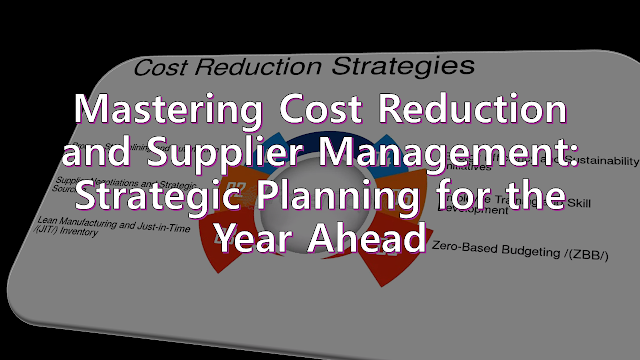Mastering Cost Reduction and Supplier Management: Strategic Planning for the Year Ahead
As the year ends and planning for the next year begins, cost reduction and supplier management become critical components for businesses, especially in manufacturing. In this blog, we’ll explore actionable strategies to achieve realistic cost savings (3-5%) while strengthening supplier relationships and optimizing procurement processes. Leveraging these insights will empower businesses to improve profitability and resilience in a competitive market.
1. Realistic Cost Reduction Goals and Strategies
1.1 Detailed Cost Analysis and Target Identification
Break down costs into categories and prioritize areas for improvement:
- A-Items: High-cost materials (~70-80% of expenses). Focus on alternatives or optimized sourcing.
- B-Items: Medium-cost components (~15-20%). Consider renegotiating contracts.
- C-Items: Low-cost, high-quantity items. Streamline consumption and minimize waste.
Pro Tip: Evaluate switching materials for key components to reduce costs. For instance, replace metal parts with high-strength plastics where feasible to maintain performance while cutting expenses.
1.2 Value Engineering
Collaborate with engineering teams to redesign products for cost-efficiency without compromising functionality.
- Identify over-specification in designs.
- Transition to modular components for easier sourcing and assembly.
Pro Tip: Partner with suppliers to co-develop solutions that reduce both their costs and yours, such as standardized components or streamlined packaging.
1.3 Supplier Collaboration
Involve suppliers in your cost-saving initiatives:
- Implement Gain-Sharing Programs, where suppliers are incentivized to suggest cost-saving ideas.
- Request suppliers to present annual cost reduction plans tailored to your needs.
Pro Tip: Conduct supplier workshops to collectively identify and implement cost-saving measures, ensuring a win-win relationship.
2. Supplier Management: Building Resilience and Efficiency
2.1 Diversify Your Supply Chain
Mitigate risks by sourcing from multiple suppliers for critical components. Aim for at least two reliable suppliers for key materials.
Pro Tip: Use competitive bidding processes for secondary suppliers while maintaining quality and delivery standards.
2.2 Long-Term Contracts with Price Stabilization
Negotiate long-term agreements with suppliers to secure better pricing and reduce price volatility.
Pro Tip: Include clauses in contracts that cap price increases or tie them to market indices, sharing cost fluctuations between you and the supplier.
2.3 Automation and Support for Suppliers
Help your suppliers adopt automation or technology that reduces their costs. Consider offering technical or financial support where it benefits your supply chain.
Pro Tip: Deploy IoT tools for real-time monitoring of supplier operations and collaborate to improve their processes for mutual benefit.
3. Optimizing Procurement Processes
3.1 Lean Manufacturing and Process Optimization
Reduce inefficiencies in production through Lean Manufacturing techniques:
- Use Value Stream Mapping (VSM) to identify bottlenecks.
- Minimize waste in materials and time across production stages.
Pro Tip: Implement preventive maintenance using IoT sensors to reduce unplanned downtime, thereby cutting hidden costs in your operations.
3.2 Energy and Resource Efficiency
Lower energy and resource costs with smarter technologies:
- Switch to energy-efficient machinery and LED lighting.
- Utilize renewable energy sources where possible.
Pro Tip: Tap into government subsidies or tax incentives for energy-efficient upgrades to minimize upfront costs.
3.3 AI-Driven Predictive Procurement
Utilize AI to forecast demand and optimize purchasing decisions. This approach minimizes overstocking or stockouts, reducing storage and operational costs.
Pro Tip: For volatile materials, use forward contracts to lock in favorable prices and reduce exposure to price fluctuations.
4. Beyond Cost: Building Sustainable Supplier Relationships
4.1 Collaborative Innovation
Encourage joint innovation projects with suppliers to unlock cost reductions while improving quality.
Pro Tip: Establish a rewards program for suppliers that meet or exceed cost and innovation targets, fostering a culture of partnership.
4.2 ESG-Compliant Sourcing
Adopt sustainable procurement practices to align with ESG (Environmental, Social, and Governance) goals, ensuring long-term benefits for both cost and reputation.
Pro Tip: Source materials from certified suppliers to meet regulatory requirements and access green subsidies.
5. Actionable Takeaways for 2024
To set your business up for success, here are three actionable steps to implement today:
- Set Realistic Cost Reduction Targets: Aim for a 3-5% reduction by focusing on high-cost areas like materials and energy.
- Revamp Supplier Collaboration: Develop a yearly cost reduction plan with your suppliers and diversify your supply chain for added resilience.
- Leverage Technology: Adopt Lean Manufacturing, AI-driven procurement, and energy-efficient solutions to unlock hidden savings.
Why This Matters
Effective cost reduction and supplier management strategies are no longer optional—they're essential for maintaining profitability in a competitive environment. By combining data-driven decision-making with collaborative supplier relationships, businesses can achieve sustainable growth while remaining agile in the face of challenges.
By implementing these strategies, you’ll be well-prepared to navigate the complexities of the coming year while driving measurable business results.



